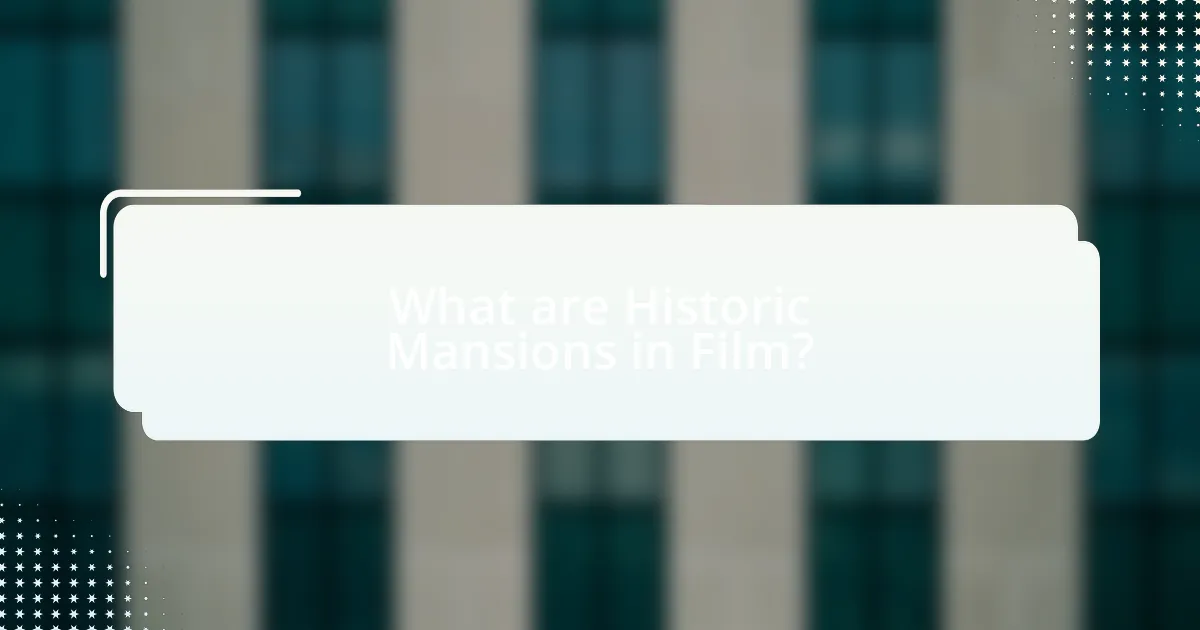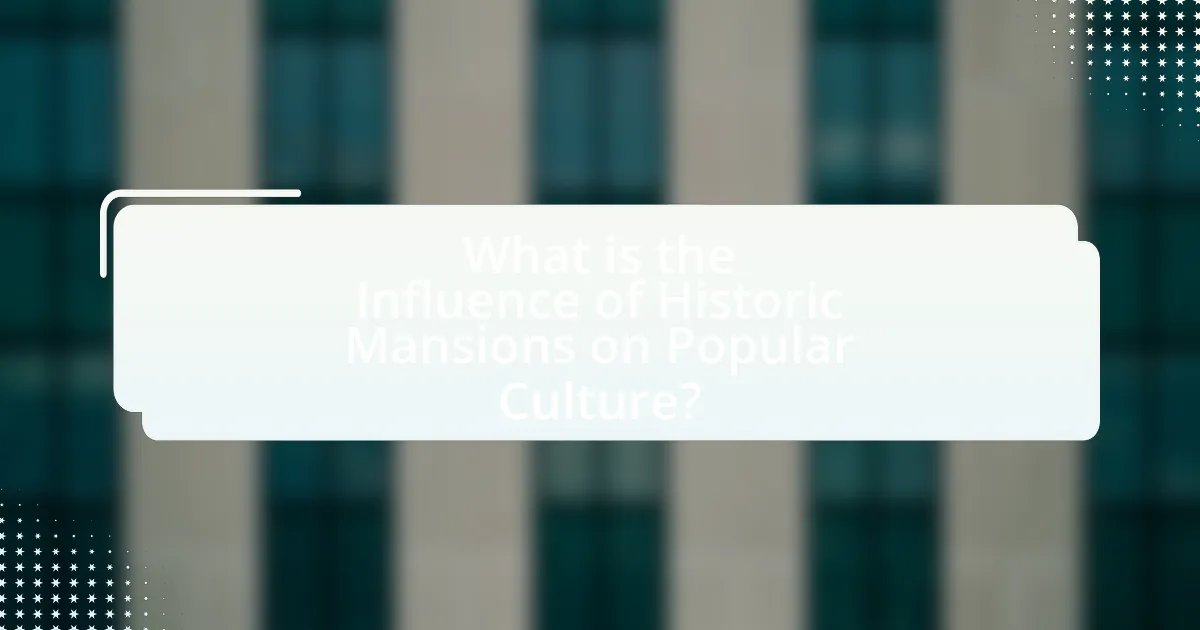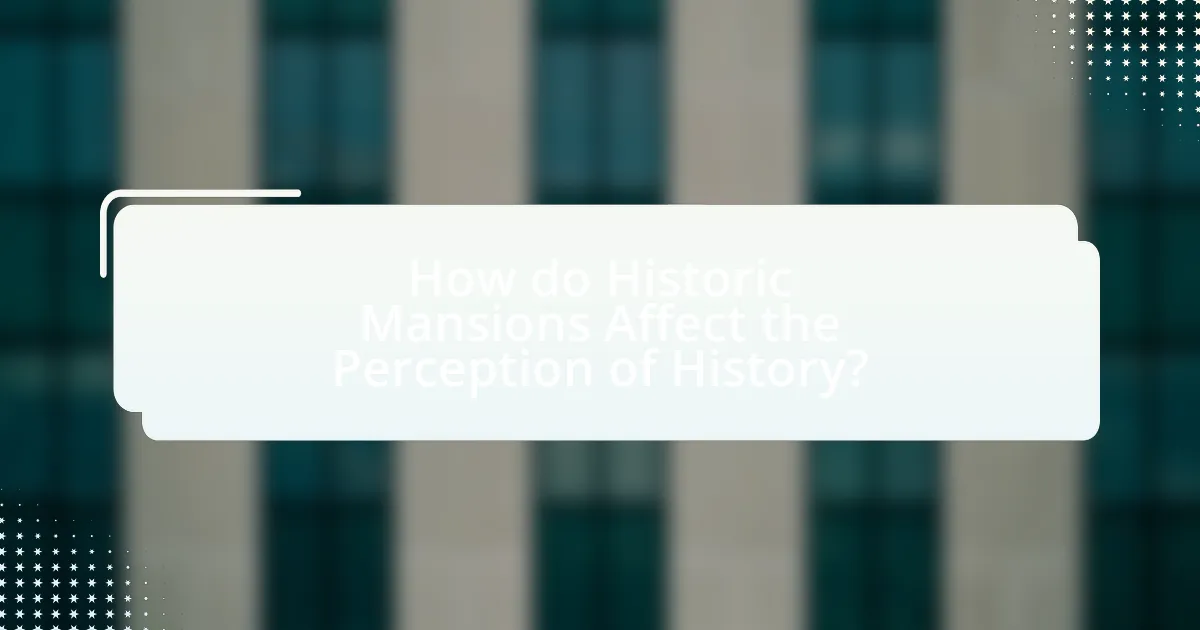Historic mansions in film are significant architectural settings that enhance storytelling by representing wealth, power, and historical context. This article explores how these grand residences influence popular culture and shape audience perceptions of history. It examines the portrayal of historic mansions in various films, highlighting their architectural features, thematic representations, and impact on character development. Additionally, the article discusses the role of these mansions in reinforcing cultural stereotypes, evoking nostalgia, and influencing tourism, while also addressing the potential misconceptions about history that arise from their cinematic depictions.

What are Historic Mansions in Film?
Historic mansions in film are grand, often architecturally significant residences that serve as key settings in cinematic narratives. These locations are frequently chosen for their historical value, aesthetic appeal, and ability to evoke specific time periods or social classes. For instance, films like “The Great Gatsby” and “Pride and Prejudice” utilize historic mansions to enhance storytelling by providing a visual representation of wealth, status, and cultural heritage. The use of such locations not only enriches the film’s atmosphere but also influences audience perceptions of history and societal norms, as these mansions often symbolize the ideals and conflicts of their respective eras.
How have historic mansions been portrayed in cinema?
Historic mansions have been portrayed in cinema as symbols of wealth, power, and often, mystery. Films frequently utilize these grand structures to evoke a sense of grandeur and historical significance, showcasing their architectural beauty and intricate designs. For instance, movies like “The Great Gatsby” and “Downton Abbey” highlight the opulence of historic mansions, reflecting the social hierarchies and cultural contexts of their respective eras. Additionally, these settings often serve as backdrops for pivotal plot developments, enhancing themes of family legacy, intrigue, and sometimes, horror, as seen in films like “The Haunting” and “The Others.” The portrayal of historic mansions in cinema not only captivates audiences but also shapes public perception of history and the lifestyles of the elite.
What architectural features are commonly highlighted in these films?
Architectural features commonly highlighted in films about historic mansions include grand facades, intricate moldings, expansive staircases, and elaborate gardens. These elements serve to convey opulence and historical significance, often reflecting the social status of the characters within the narrative. For instance, films like “The Great Gatsby” showcase lavish interiors with high ceilings and ornate chandeliers, emphasizing the wealth and extravagance of the era. Additionally, the use of large windows and expansive balconies in these films often symbolizes openness and grandeur, further enhancing the visual storytelling.
How do filmmakers choose specific mansions for their narratives?
Filmmakers choose specific mansions for their narratives based on the architectural style, historical significance, and thematic relevance to the story. The architectural style of a mansion can visually convey the era and social status of characters, while historical significance can add depth and authenticity to the narrative. For instance, the use of the Winchester Mystery House in films like “Winchester” highlights its unique history and architectural anomalies, enhancing the film’s themes of mystery and the supernatural. Additionally, filmmakers often consider how a mansion’s ambiance and setting can evoke specific emotions or support the plot, as seen in “The Great Gatsby,” where opulent mansions symbolize wealth and excess, aligning with the film’s critique of the American Dream.
Why are historic mansions significant settings in films?
Historic mansions are significant settings in films because they embody a sense of grandeur, history, and character that enhances storytelling. These architectural landmarks often serve as visual metaphors for themes such as wealth, power, and decay, which are prevalent in various genres, particularly in dramas and thrillers. For instance, films like “The Great Gatsby” utilize opulent mansions to reflect the excesses of the Roaring Twenties, while horror films often feature dilapidated estates to evoke fear and mystery. The historical context of these mansions adds depth to narratives, allowing filmmakers to explore societal issues and human emotions through their rich backstories and intricate designs.
What themes do historic mansions represent in storytelling?
Historic mansions in storytelling represent themes of power, legacy, and the passage of time. These grand structures often symbolize wealth and social status, reflecting the historical context of their construction and the families that inhabited them. For instance, in literature and film, mansions frequently serve as backdrops for narratives exploring family dynamics, secrets, and the consequences of past actions, as seen in works like “The Great Gatsby,” where the mansion embodies the opulence and moral decay of the era. Additionally, historic mansions often evoke nostalgia and the idea of lost grandeur, illustrating how time affects both physical structures and human relationships. This thematic representation is reinforced by the architectural details and historical significance of these buildings, which contribute to their role as symbols of cultural heritage and societal change.
How do these settings influence character development?
Settings, particularly historic mansions in film, significantly influence character development by providing a backdrop that shapes characters’ motivations, behaviors, and relationships. For instance, the grandeur or decay of a mansion can reflect a character’s social status or internal struggles, as seen in films like “The Great Gatsby,” where the opulence of Gatsby’s mansion symbolizes his wealth and the emptiness of his pursuits. Additionally, the architectural features and historical context of these settings can evoke specific emotions and memories, impacting how characters interact with their environment and each other. This interplay between setting and character is crucial in conveying themes and driving narrative arcs, as evidenced by the way characters in gothic films often embody the tension between their desires and the oppressive nature of their surroundings.

What is the Influence of Historic Mansions on Popular Culture?
Historic mansions significantly influence popular culture by serving as iconic settings in films, literature, and art, which shape public perception of history and heritage. These grand structures often symbolize wealth, power, and mystery, making them compelling backdrops for storytelling. For instance, films like “The Great Gatsby” and “Gone with the Wind” utilize historic mansions to evoke specific historical contexts and social dynamics, thereby reinforcing cultural narratives. Additionally, the architectural styles and historical significance of these mansions contribute to their portrayal in media, influencing how audiences perceive both the past and contemporary society.
How do historic mansions shape audience perceptions?
Historic mansions shape audience perceptions by serving as symbols of wealth, power, and historical significance. These architectural structures often evoke a sense of nostalgia and grandeur, influencing how viewers interpret the narratives presented in films and media. For instance, films featuring historic mansions frequently depict them as settings for pivotal moments, reinforcing their association with social status and historical events. Research indicates that the visual representation of such mansions can enhance emotional engagement and authenticity in storytelling, as audiences connect the opulence of these buildings with the characters and plots unfolding within them. This connection is evident in films like “The Great Gatsby,” where the mansion serves as a critical element in conveying themes of aspiration and the American Dream.
What cultural stereotypes are reinforced by these portrayals?
Cultural stereotypes reinforced by portrayals of historic mansions in film include the association of wealth and power with aristocratic lineage, the depiction of the upper class as morally ambiguous or decadent, and the portrayal of historic homes as haunted or cursed, reflecting societal fears of the past. These stereotypes are evident in films like “The Great Gatsby,” where opulence signifies both privilege and moral decay, and “The Others,” which uses the mansion setting to evoke themes of isolation and supernatural dread. Such representations shape public perception, suggesting that wealth is inherently linked to moral complexity and that historic spaces carry the weight of their histories, often amplifying fears and myths surrounding the elite.
How do historic mansions contribute to the nostalgia in films?
Historic mansions contribute to nostalgia in films by serving as visual symbols of a bygone era, evoking memories and emotions associated with the past. Their architectural grandeur and historical significance often transport viewers to a time characterized by elegance and tradition, enhancing the film’s emotional depth. For instance, films like “The Great Gatsby” utilize opulent mansions to reflect themes of wealth and social status, while simultaneously invoking a sense of longing for a romanticized past. This connection is reinforced by the use of period-specific details in the set design, which further immerses the audience in the historical context, making the nostalgia more palpable.
In what ways do historic mansions inspire fashion and design trends?
Historic mansions inspire fashion and design trends through their architectural styles, historical significance, and opulent interiors. The grandeur of these estates often influences contemporary designers, who draw on elements such as intricate moldings, lavish fabrics, and period-specific color palettes. For instance, the Victorian era’s emphasis on ornate details can be seen in modern fashion collections that incorporate lace, ruffles, and rich textures. Additionally, films featuring historic mansions, like “The Great Gatsby,” showcase these elements, leading to a resurgence of 1920s fashion trends, including flapper dresses and tailored suits. This connection between historic mansions and modern design is evident in the way designers reference these iconic structures to evoke a sense of nostalgia and elegance in their work.
What elements of mansion aesthetics are adopted in modern culture?
Modern culture adopts several elements of mansion aesthetics, including grand architectural features, opulent interiors, and expansive gardens. These elements are often reflected in contemporary design through the use of high ceilings, large windows, intricate moldings, and luxurious materials like marble and crystal. The influence of historic mansions is evident in popular media, where films frequently showcase these lavish settings to evoke a sense of wealth and sophistication, reinforcing societal ideals of luxury. For instance, films such as “The Great Gatsby” and “Downton Abbey” prominently feature mansion aesthetics, which have led to a resurgence in interest for similar designs in modern homes and public spaces.
How do films featuring historic mansions influence tourism?
Films featuring historic mansions significantly influence tourism by increasing public interest and visitation to these sites. For instance, movies like “The Great Gatsby” and “Downton Abbey” have led to a surge in tourists visiting the mansions depicted, as evidenced by a 2014 report from the National Trust for Historic Preservation, which noted a 20% increase in visitors to properties featured in films. This phenomenon occurs because films often romanticize and showcase the architectural beauty and historical significance of these locations, prompting audiences to seek out the real-life experiences associated with them. Additionally, the portrayal of these mansions in popular media enhances their visibility, making them desirable destinations for fans and history enthusiasts alike.

How do Historic Mansions Affect the Perception of History?
Historic mansions significantly shape the perception of history by serving as tangible representations of past architectural styles, social hierarchies, and cultural narratives. These structures often embody the historical context in which they were built, reflecting the values, aesthetics, and lifestyles of their time. For instance, the preservation of mansions like Mount Vernon, George Washington’s estate, allows for a deeper understanding of early American life and the complexities of the nation’s founding. Furthermore, their portrayal in films and media reinforces historical narratives, influencing public perception by romanticizing or critiquing the eras they represent. This dual role as both historical artifacts and cultural symbols underscores their impact on how history is interpreted and understood.
What role do historic mansions play in historical narratives within films?
Historic mansions serve as significant backdrops in historical narratives within films, enhancing authenticity and providing visual context to the story. These architectural structures often embody the cultural, social, and economic conditions of their respective eras, allowing filmmakers to convey historical themes effectively. For instance, films like “The Great Gatsby” utilize opulent mansions to reflect the extravagance of the 1920s, while “Downton Abbey” showcases the class distinctions of early 20th-century Britain through its estate setting. Such representations not only enrich the narrative but also influence audience perceptions of history by evoking a sense of time and place, thereby reinforcing the film’s historical accuracy and emotional resonance.
How do filmmakers balance historical accuracy with creative storytelling?
Filmmakers balance historical accuracy with creative storytelling by selectively incorporating factual elements while enhancing narrative engagement. They often conduct thorough research to ensure key historical events and figures are represented accurately, as seen in films like “Lincoln,” which portrays President Abraham Lincoln’s efforts to pass the 13th Amendment. However, filmmakers may also take creative liberties, such as altering timelines or character interactions, to enhance dramatic tension or emotional impact. This approach allows them to maintain viewer interest while still providing a framework of historical truth, exemplified by the use of real historical settings, like historic mansions, to ground the story in a recognizable context.
What impact do these films have on public understanding of history?
Films featuring historic mansions significantly shape public understanding of history by dramatizing and visualizing historical events and contexts. These films often depict real historical figures and events, making complex narratives more accessible and engaging for audiences. For instance, movies like “The Great Gatsby” and “Downton Abbey” illustrate the social dynamics and cultural contexts of their respective eras, allowing viewers to grasp the nuances of historical periods. Additionally, research indicates that visual storytelling can enhance memory retention of historical facts, as seen in studies by the American Psychological Association, which show that narratives improve recall compared to traditional educational methods. Thus, these films serve as powerful tools for educating the public about history while also influencing perceptions and interpretations of the past.
How can the portrayal of historic mansions lead to misconceptions about the past?
The portrayal of historic mansions can lead to misconceptions about the past by romanticizing or oversimplifying their historical significance and the lives of their inhabitants. For instance, films often depict these mansions as symbols of wealth and grandeur, neglecting the complex social, economic, and political contexts that shaped their existence. This selective representation can create a skewed understanding of history, as audiences may assume that the lifestyles portrayed are universally applicable or reflective of the broader societal conditions of the time. Additionally, the focus on aesthetics and drama in cinematic portrayals often overlooks the realities of the labor and social hierarchies that supported such estates, leading to a distorted view of historical narratives.
What are some examples of films that misrepresent historical facts related to mansions?
Films such as “The Great Gatsby” and “Gone with the Wind” misrepresent historical facts related to mansions. “The Great Gatsby” portrays the opulence of the 1920s through the fictional mansion of Jay Gatsby, but it simplifies and romanticizes the era’s social dynamics and economic disparities. Similarly, “Gone with the Wind” features the plantation mansion Tara, which presents a nostalgic view of the antebellum South, glossing over the harsh realities of slavery and the socio-economic conditions of the time. Both films contribute to a distorted perception of historical mansions and their significance in American history.
How do audiences differentiate between fact and fiction in these portrayals?
Audiences differentiate between fact and fiction in portrayals of historic mansions by analyzing visual cues, narrative context, and historical accuracy. Visual cues, such as architectural details and period costumes, help viewers assess authenticity, while narrative context provides insight into the intended representation of historical events. Historical accuracy can be evaluated through research and comparison with documented facts, such as architectural styles and significant events associated with the mansions. For instance, films that accurately depict the design of a mansion, like the use of Georgian architecture in “The Haunting of Hill House,” reinforce the factual basis of the portrayal, while those that take creative liberties may signal a fictional interpretation.
What practical insights can we gain from the depiction of historic mansions in film?
The depiction of historic mansions in film provides practical insights into architectural styles, cultural values, and historical contexts. These films often showcase specific design elements, such as neoclassical or Victorian architecture, which can inform viewers about the aesthetic preferences and technological capabilities of different historical periods. For example, movies like “The Great Gatsby” highlight the opulence of the 1920s, reflecting societal values of wealth and status during that era. Additionally, the portrayal of these mansions can influence public perception of history, as films often dramatize events or lifestyles associated with these structures, shaping collective memory and cultural narratives. This interplay between architecture and storytelling underscores the importance of historic mansions as symbols of cultural identity and historical significance.

Leave a Reply